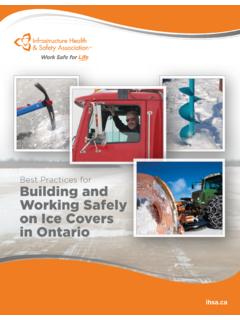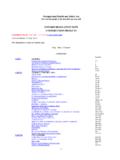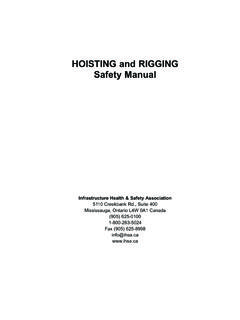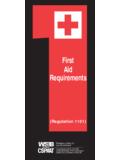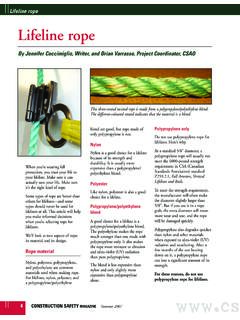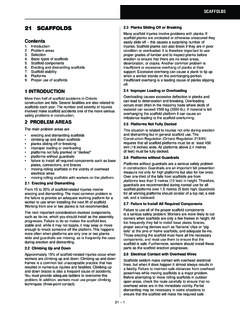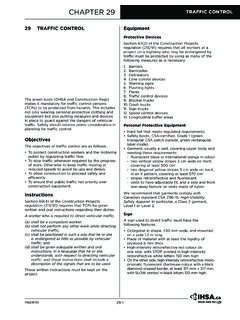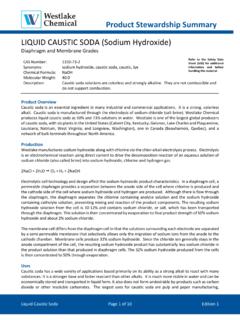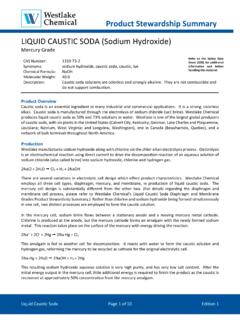Transcription of 33 PULP AND PAPER MILLS The two common forms of …
1 33 133 PULPANDPAPERMILLSP rocessesA numberofpro cesses, groupedbytypeasmmeecchhaanniiccaall,cchh eemmiiccaall, and sseemmii--cchheemmiiccaall(or hhyybbrriidd), are used inth e preparation of wood pulp. In 1990 (according toLockwoo d s Directory) the distribution of pulp MILLS inOntario and Queb ec was as follows:In chemical pulpin g, the wood chip s are co oked, usingheat and a chemical solution th at depends on the type ofpro cess being used. The lignin bin der, a natural glue thathold s the wood cells (fibres) together, is dissolv two common forms of chemical pulping are1) the dominant alkaline or kraft process, and2) the acid pulping or sulphite pulping has generally declined but is still in use.
2 Thedigester liquor is a solution of sulphurous acid, H2SO3,mixed with lime (CaO) or other base (magnesium,sodium, or ammonium) to form processes produce the highest yield from thewood, but have high energy demands. Mechanical pulpinggenerally incorporates thermal or chemical pre-softeningof the wood chips, resulting in lower energy chemical processes include mechanical division is not distinct and is generally based onefficiency of production from dry provides a flow diagram for a semi-chemicalpulp the ch em ical processes, alkaline pulping the kraftor sulphite process is the most common and is shown inFigure AND PAPER MILLSC hemica l Pro ce ss esSemi-c hemicalMechanicalTotalKraftSulp hiteOntario9421530 Quebec10824161 Figur e 22.
3 1 : N um ber of pulp MILLS by typ e in Ont ar io and Que be cProc es s Type33 2Kr aft P rocessThe kraft process consists of th ree principal operations:1) cooki ng and washing2) evaporation and a lka li recovery3) causticizing and lime debarking and chippin g, the chipped wood is"cook ed " or digested with steam at a pressure ofapproximately 150 psig ( kPa) in the digester with asolut io n of sodium hydroxide (NaOH) and sodium sulphid e(NaS2) known as whit e liquor. After cooking for about sixhours, the lignin binder is dissolv ed and the cellulosefi br es, now calle d pulp or brown stock, are separatedfr om the spent cooking liq uor (black liquor) in the pulpwasher s.
4 T he kraft process is associated with strong-smell ing gases organic sulphides which are anenvironmental dil ut e or wea k black liquor (10-15% solids) comesfr om the washers . After concentratio n by removal of waterin the mult ip le-effect evaporator using steam, the resulting"h eavy" black liquor usually goes through furtherconcentration in a dir ect-contact ev concentrated black liquor then goes to the mix tankwher e the sodium su lp hate (salt cake) is mixed with theli quor to make up the chemical losses in the system.
5 The"h eavy" black liquor (60-70% solids), with its salt cakeburden, i s heate d to lo wer its viscosity and pumped to therec overy f urnace where it is sprayed on the walls fordehydratio n prior to final combustion of the dried char onth e hearth. Sodium sulphate dust in the boiler gases isremoved by an electrostatic int ense heat in the furnace fuses the inorganicel ements of the black l iquor (mainly sodium carbonate andso dium sulphide) to form what is known as smelt. The smeltis tapped from the furnace and runs into a dissolving tankwhere it is mi xed wi th water to form green liquor.
6 Carb on and other impurities in the green liquor are settledout i n a clarif ie r, filtered, and sent to landfill. The clarifiedgr een li quor is subjected to a causticizing treatment withhot l im e, Ca(OH)2, i n a l ime slaker to convert sodiumcarbonate in to sodium hydroxide. T he insoluble calciumcarbonate mud produced is settled out and reused. Theres ul ti ng sodium of sodium hydroxide and sodiu msulph id e, now calle d white liq uor , is reused as cookingli quor f or the wood chips in the dig blea ching of brown pulp to white pulp is usuallyaccomplished with chlorine, followed by extraction withsodiu m hydroxide, then calcium or sodiu m hypochlorite,and fina lly a chlorine d ioxide tenance work in operating pulp and PAPER MILLS canpre sent a number of special hazards to constructionworke rs.
7 I n addition to the trade hazards associated withwhat is common ly encountered in new constructio n, thereare other hazards:1)ha zardous process chemicals2)pi pin g systems3)he at4)noise5)pinchpoints and moving following information is provided to help constructioncrews recognize, assess, and control these hazards inpulp and PAPER ) Hazardous Pr ocess Chemic alsGeneralOf the man y different hazardous chemicals used, mostare fou nd in the parts of the mill that digest or break downthe woo d fibres. The cooking liquors described above(white liquor, green liquor, and black liquor) all tend to bevery corrosive and may contain several different toxic orhazardous precautions should be taken when working intanks or vessel s used for these liquors or when working onrel ated pipi ng.
8 Haz ardous chemicals may be encounteredin storage tanks, process piping, process equipment, wastehandling systems, and environmental control addition to these "contained" sources, some processesmay emit gases, vapours, or dusts that may behazardous. Always be aware of potential emissions orleaks from adjacent operating or apparently isolatedequipment or storage residues may also be le ft as potential exposuresto maintenance and construction personnel. Extremeprecautions should be taken when working in tanks orvessels. During maintenance or repair operations insideproduction equipment, confined space procedures mustbe established and followed ExposuresFollowing are some of the potential exposures fromvarious parts of the est erPotential exposures include organic sulphur compounds,primarily methyl mercaptan, ethyl mercaptan, dimethylsulphide and dimethyldisulphide, in addition to hydrogensulphide and sulphur a nd RecoveryEvaporators are sources of hydrogen sulphide andsulphur dioxide and require precautions, especially duringmaintenance.
9 When they become plugged, precautionsmust be taken while cleaning them with nitric acidsolutions. Repair and maintenance around digesters,evaporators, and furnaces also offer potential exposure tocaustic liquors and asbestos. Air emissions associatedwith recovery boilers contain sulphur dioxide, sodiumsulphate particulate, and salt cake (basically a nuisancedust). Duct systems, electrostatic precipitators forparticulates, and wet scrubbers for SO2requireappropriate precautions during and Lime RecoveryIn addition to exposure to caustics, potential exposuresinclude calcium oxide (quicklime) and calcium hydroxidedusts, par ticularly during ti al exposu res in cl ud e ch lo ri ne and ch lori ne di ox id e PULP AND PAPER MILLS33 3(CI O2)
10 Whi ch i s a severe pulmonar y irritant even at lowconcen trations usu ally encountered only during upsetsor pe r M ach ine sPotentia l exposures include dusts from cleaners,sli mi cides , pH contr ol chemicals, and off-gassing offo rmaldehyde and c P ro ces s Chemica l HazardsAl though the kraft, or alkalin e, process is the mostcommon , there are other pulping processes. The sulphitepro cess involves acid cooki ng in which the digester liquoris a solu tion of sulp hurous acid mixed with lime or otherbase to f orm lists some of the major chemicals used orencountered in different processes.

